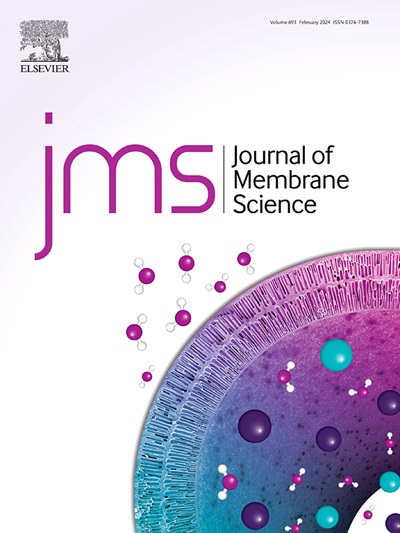2D/2d nanoconfined catalytic membrane for efficient water purification under photocatalysis-assisted peroxymonosulfate activation system
IF 9
1区 工程技术
Q1 ENGINEERING, CHEMICAL
引用次数: 0
Abstract
Two-dimensional (2D) lamellar membranes offer excellent separation performance for organic pollutants; however, their broader application is limited by the permeability-selectivity trade-off, membrane fouling, and challenges in treating concentrated pollutants. Integrating membrane filtration with advanced oxidation processes (AOPs) is a promising approach to address these limitations. In this study, a porous 2D/2D nanoconfined catalytic membrane (CN@Co/Fe-MOF) was developed for the continuous removal of pollutants. Upon photoexcitation, the photogenerated electrons (e−) from g-C3N4 nanosheets were effectively separated and transferred to Co/Fe-MOF nanosheets, promoting the valence cycling of Fe/Co active sites and enhancing the peroxymonosulfate (PMS) activation to generate singlet oxygen (1O2). This system achieved the high-flux pollutant removal (70.41 L m−2 h−1), with the efficiencies of 98.7 % for rhodamine B, 99.11 % for evans blue, 96.83 % for methylene blue, 97.99 % for methyl orange, 98.3 % for acid orange G, and 89.78 % for tetracycline hydrochloride. Molecular dynamics (MD) simulations revealed rapid water transport through the layered porous hydrophilic structure, whereas density functional theory (DFT) calculations demonstrated that the nanoconfined channels thermodynamically facilitated spontaneous PMS dissociation at Co/Fe active sites. This work provides strategic insights into the design of heterogeneous catalytic systems and a mechanistic understanding of pollutant degradation under nanoconfinement.

光催化辅助过氧单硫酸盐活化体系下的二维/二维纳米限制催化膜高效水净化
二维(2D)层状膜对有机污染物具有优异的分离性能;然而,它们的广泛应用受到渗透性-选择性权衡、膜污染和处理高浓度污染物方面的挑战的限制。将膜过滤与高级氧化过程(AOPs)相结合是解决这些限制的一种很有前途的方法。在本研究中,开发了一种用于连续去除污染物的多孔2D/2D纳米限制催化膜(CN@Co/Fe-MOF)。光激发后,g-C3N4纳米片上的光生电子(e−)被有效分离并转移到Co/Fe- mof纳米片上,促进了Fe/Co活性位点的价循环,增强了过氧单硫酸根(PMS)的活化,生成单线态氧(1O2)。该系统实现了高通量的污染物去除率(70.41 L m−2 h−1),其中罗丹明B的去除率为98.7%,埃文思蓝为99.11%,亚甲基蓝为96.83%,甲基橙为97.99%,酸橙G为98.3%,盐酸四环素为89.78%。分子动力学(MD)模拟揭示了水通过层状多孔亲水结构的快速运输,而密度泛函理论(DFT)计算表明,纳米限制通道在热力学上促进了Co/Fe活性位点的自发PMS解离。这项工作为多相催化系统的设计和纳米约束下污染物降解的机理理解提供了战略见解。
本文章由计算机程序翻译,如有差异,请以英文原文为准。
求助全文
约1分钟内获得全文
求助全文
来源期刊

Journal of Membrane Science
工程技术-高分子科学
CiteScore
17.10
自引率
17.90%
发文量
1031
审稿时长
2.5 months
期刊介绍:
The Journal of Membrane Science is a publication that focuses on membrane systems and is aimed at academic and industrial chemists, chemical engineers, materials scientists, and membranologists. It publishes original research and reviews on various aspects of membrane transport, membrane formation/structure, fouling, module/process design, and processes/applications. The journal primarily focuses on the structure, function, and performance of non-biological membranes but also includes papers that relate to biological membranes. The Journal of Membrane Science publishes Full Text Papers, State-of-the-Art Reviews, Letters to the Editor, and Perspectives.
 求助内容:
求助内容: 应助结果提醒方式:
应助结果提醒方式:


